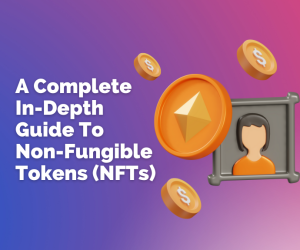Blockchain Security: Key Concerns and Ways to Prevent Them
- September 1, 2023
- 2234 views
- 14 minutes

There is no denying that blockchain technology is completely transforming the way we transact online. But is it secure enough?
With the drastic rise in cyber-attacks against online payments and data servers, the question is very much relevant in this present state. Although blockchain boasts a decentralized system backed by data integrity and verifiability, new forms of security threats are coming to light every passing day.
Well, no technology is 100% secure, and blockchain is no exception to this! Hence, understanding the potential security risks is the first and foremost step in building trust in that technology.
Which types of blockchain are more prone to cyber-attacks, which are considered safest, and how to protect your blockchain against these vulnerabilities? Let’s uncover all the details in this article.
Table of Content
I. Introduction
Before we begin with security risks in a blockchain and ways to prevent them, let us first have a clear understanding of blockchain.
Definition Of Blockchain Technology: A Quick Recap
Blockchain is a distributed ledger technology (DLT) that enables users to make transactions and store data in a decentralized peer-to-peer (P2P) network. Every record or transaction made by the users is stored in the blocks as nodes. Every time a new transaction occurs, a new node gets added to the blocks, thus forming a chain. Hence, the name blockchain.
Since it is a shared immutable public ledger, transparency is one of the key attributes of blockchain. Anyone can access or view the blockchain network but cannot edit or remove data from the network.
The whole premise of blockchain is based on decentralized authority, which obviates the need for a centralized point of control or intermediary.
Importance Of Security Measures For Private Blockchain
Blockchain basically relies on cryptography technology which ensures its security. Through cryptographic hashing, records are end-to-end encrypted which cannot be reversed.
Although blockchain sounds very promising and appealing to a variety of businesses, it is also vulnerable to security risks. Hence, certain security measures must be implemented to protect the network against hackers.
The ideals of blockchains are based on decentralization, immutability, and transparency, making it even more important to assure the integrity and dependability of blockchain networks. Ensuring blockchain security is of paramount importance to guarantee the viability of the technology in the long term.
Like every other technology, blockchain also has some loopholes that malicious attackers can turn to their advantage to perform fraudulent activities.
So, without further ado, let’s delve into the types of security breaches that are possible in blockchain networks and learn how to prevent them.
Read Also: Exploring The Benefits of Private Blockchain In Businesses
II. Types of Security Threats
How Security Varies by Blockchain Types
First of all, security threats differ by blockchain type and so do their preventive measures. Blockchain is classified into two broad categories – Public blockchain and Private blockchain.
Bitcoin is the ideal example of a public blockchain that is accessible to the public and hence, anyone can join the network, participate in transactions, and validate them.
A Private blockchain is a private network that is partly decentralized and requires an invitation to join. Users are validated by the network’s administrator for participation.
This is the most significant area of difference between private and public blockchains. Since public blockchain is based on a completely decentralized network architecture where anyone can participate, it lacks privacy which raises security concerns by the users.
Compared to a public blockchain, a private blockchain offers greater privacy but still is vulnerable to cyber-attacks because they are smaller networks which makes an easy way to data manipulation.
Overview Of Security Threats Faced By Blockchains
Blockchain technology isn’t perfect in terms of security and this gives way to cyber criminals to tamper with the data and cause severe loss to businesses.
According to a study by Comparitech, some of the most expensive breaches took place in 2021. DeFi alone stands for a crypto money loss of $1.4 billion. Exploitation of decentralized finance (DeFi) protocols was, perhaps, the fastest and easiest way for hackers to steal crypto.
Here’s an overview of the types of security threats associated with blockchain.
Routing Attacks
Large amounts of data transfers are made in real-time on a blockchain network and routing attacks can happen when any resourceful hacker meddles with the routing configurations.
They can block the data on its way to Internet Service Providers (ISPs) which, most of the time, goes unnoticed by the blockchain users. By intercepting the unencrypted blockchain network traffic, they can easily access, alter, and tamper with the data.
Phishing Attacks
This old and classic hacking tactic doesn’t even spare the new-age blockchain technology. Phishing attacks are a type of scam where cyber attackers send random false emails to owners convincing them to share their credentials.
At most times, users fall prey to these types of scams thinking they are actually from the network administrator. They eventually end up sending the login credentials and access details of their accounts and wallets.
51% Attacks
As discussed earlier, Public blockchains are large-scale networks involving gigantic amounts of computing power for the purpose of mining. Here, unethical miners try to get complete control over the public ledger.
Their mission gets accomplished when they are able to seize control of the network’s mining power by more than 50%. That’s why the name – 51% attacks.
Private blockchains, being small-scale and private chain networks, are not vulnerable to 51% attacks.
Sybil Attacks
In the case of Sybil attacks, hackers flood the blockchain network with overwhelming numbers of fake identities, thus leading to system crashes.
The key objective of the attackers is to undermine the power of the controlling authority in a reputed system and gain disproportionate influence in the network. The false identities serve as the majority who now control the decisions made in the blockchain.
Eclipse Attack
This is a network-based attack that occurs in the peer-to-peer network, most common in the world of cryptocurrencies. An eclipse attack is a process of duplicating nodes and then eclipsing (hiding) the original nodes from the users.
The victims are broadcasted the fake node containing false information which was created by the hackers. This way a hacker tries to redirect the connections of the targeted victim from legitimate nodes to hacker-controlled nodes.
Read Also: Private Blockchain Vs. Banks: Will Blockchain Revolutionize Banking?
III. Top Examples of Blockchain and DLT Security Breaches To Know
Every stakeholder involved in the blockchain network, from administrators to participants, and crypto investors to others, should be aware of the potential weakness of this DLT technology.
To help you better understand the different types of blockchain thefts, we have listed here the top five cases of security breaches in Blockchain.
- Wormhole: In February 2022, the cryptocurrency platform named Wormhole was hacked which led to a loss of $326 million. But the good news is that the corporation fixed the security issue in just 6 hours after the cyber attack.As per reports, the attack was executed by hackers through the creation of faulty validations of users’ accounts. The company, after recovering from the attack, made an official announcement on Twitter stating that all funds were restored and returned to investors early the next day.
- Liquid Global: Liquid is a popular cryptocurrency exchange platform that experienced a major setback in August 2021 when hackers gained unauthorized access to Liquid’s hot wallet. They instantly transferred cryptocurrencies whose total worth was over $97 million.Hackers stole leading crypto coins like Bitcoin, Ether, XRP, and other 66 cryptocurrencies. However, maximum damage occurred due to Ethereum assets as hackers broke into the hot wallet of Liquid to steal Ethers.After the theft, the hackers transferred a chunk of the stolen assets using top crypto trading platforms such as UniSwap. But later most of the transactions were withheld by the platforms upon Liquid’s request.To compensate for the loss, the company borrowed $120 million from its parent organization FTX, and reimbursed the losses of its customers.
- Poly Network: The Poly Network example is an intriguing case of blockchain theft where the hacker turned the flaws of the platform infrastructure to his advantage and swiped off funds worth around $600 million.The hacker was clever enough to offer a refund of the majority of the stolen assets, except $33 million USDT (Tether) which was locked by issuers.Unfortunately, the game doesn’t end here! Over $200 million of the funds refunded were sealed away in an account that requires a private key from both Poly Network and the attacker to unlock.The hacker and its team, once again, made a ploy by refusing to share away credentials which forced the company to plead with them. The issue was finally resolved after Poly Network agreed to reward them $500,000 for identifying the flaw in their cross-chain protocol.
- BitMart: Although BitMart is the most trusted cryptocurrency exchange platform in the world, its security was also compromised in December 2021. The hackers got access to the two hot wallets that were linked to BitMart with the help of a stolen private key.The hacked private key broke the encryption of the wallets that were meant to be kept secret, thus leading to a withdrawal of large amounts of assets worth around $150 million.BitMart reported on Twitter about the incident and the amount of loss in the heist. The company’s CEO, Sheldon Xia, assured its customers of finding solutions to improve platform security and reimbursing them with corporate funds.
- MT Gox: The cyber attack of MT Gox is also worth mentioning here because it is the biggest Bitcoin exchange theft to date. In fact, this exchange robbery was not a single-shot incident, but a series of events from 2011 to 2014, resulting in its bankruptcy shortly thereafter.Over the span of these three years, hackers were continuously looting money by gaining unauthorized access to over 850,000 bitcoins from the site and its users whose value at that time was $470 million.After this security breach, MT Gox abruptly ceased its operations, leaving a significant impact on the entire crypto industry. At present, it’s a defunct crypto exchange but several new regulatory changes were implemented after MT Gox’s collapse in 2014.
IV. Best Practices for Ensuring the Security of Blockchain
It is clear by now that the cybersecurity landscape of blockchain certainly has some loopholes. Therefore, the challenge for the industry stakeholders is to eliminate all kinds of potential security risks and prevail over malicious attackers.
Professional blockchain developers together with cybersecurity experts have a grasp of novel security risks and are implementing the best measures to make the whole blockchain ecosystem secure for users.
- Strong Authentication Measures
Identity and Access Management (IAM) control is the key step to ensure security across a blockchain network. Implementing strong authentication steps like Multi-factor Authentication (MFA) for both users and participants can strengthen the security in the chain.Another mechanism that can be used here is the Role-based Access Control (RBAC). This ensures that only authorized members or personnel as per his or her role can access the data and interact with the network. - Data Encryption
Securing all the data and critical information stored in the blockchain with end-to-end encryption is a must. As the information passes through nodes in the chain, the encryption technology prevents unauthorized users from accessing or reading the data.The science of encrypting information by converting it into secure code which can be unlocked only with a unique digital key is known as cryptography. Hence, when your data is end-to-end encrypted, you can have peace of mind that even if hackers get access to the network, the information remains unreadable. - Smart Contract Testing
Auditing the codes of the smart contracts and performing risk assessment at frequent intervals is imperative in detecting potential weak points. These weaknesses, if not addressed at the right time, result in disastrous ramifications.This is why rigorous security testing of smart contracts is one of the necessary practices to uncover all the potential threats and make your blockchain immune to cyber theft and intrusions. - Decentralization Consensus Mechanism (DCM)
Consensus Mechanisms can help you secure your blockchain network from any kind of attack. There is no single point of failure in a decentralized and distributed network and hence, it offers better protection.Examples of DCM are Proof of Stake (POS) and Proof of Work (POW) where the former is a cryptocurrency consensus mechanism where validators are randomly selected to process transactions and form a new block.Proof of Work (POW) differs slightly from POS in the sense that rather than selecting validators randomly, it leverages a competitive validation method. - Blockchain Penetration Testing
Beside smart contract testing, Blockchain network creators and owners should go for Penetration testing to assess the security strength of the network.Blockchain penetration testing encompasses performance testing, security testing, API testing, functional testing, and integrating testing. The test is done by ethical hackers who attempt to hack the system to identify the vulnerabilities.By exploiting the potential risks, ethical hackers or trusted cybersecurity professionals fix those security loopholes before they get exploited by cybercriminals. - Regular Security Updates
Staying abreast of the regular updates of the blockchain platform ensures that it is protected against potential attacks. Keeping track of timely updates and implementing them right away minimizes the chances of security breaches by malicious hackers.So, always be well-informed of the security patches and the related tools that you can use to secure your platform from a newly discovered threat or vulnerability.
Read Also: Smart Contract in Private Blockchain: All You Need To Know
V. Measures Users Need To Implement To Enhance Blockchain Security
The users too need to become more responsible and follow some practices to evade every possibility that fraudsters can take advantage of.
- Use Cold Wallet – Instead of hot wallets, users are recommended to store their cryptocurrencies in cold wallets which can be disconnected from the Internet. Keeping your private keys offline makes it safe from cyber attacks.
- Secure the Internet Connection – Most cases of successful hacking attempts were made on public WiFi networks because it’s easy for them to install malware and steal sensitive information. So, if you avoid using public networks during transactions, you can keep your money as well as private information safe.
- Avoid Phishing – Users should be aware of phishing scams and never click on suspicious links, malicious advertisements, or spammy emails. Such activities and email addresses should be immediately blocked and reported to the administrator.
- Wise Password Use – Another great trick to prevent security attacks by users is the use of very strong passwords incorporating upper case and lower case alphabets, special characters, and numbers. Weak passwords that are easy to guess can be the cause of the attack. Also, keep changing your password regularly.
- Security of devices – Whatever device you are using to access the network, it should be up to date with the installation of the latest antivirus software. Further, security patches must be fixed immediately.
- Secure Keys – Blockchain networks require keys to access and users must ensure to use strong cryptographic keys which shouldn’t be shared with other users.
- Using Private blockchain – Private blockchain is a permissioned network where a user can join only after invitation, once the user is verified. It is a completely controlled private network where any outsider cannot participate without permission. Hence, a private blockchain is comparatively more secure than a public blockchain.
VI. Top 6 Blockchain Security Examples
In this section, we have put together a handful of best cases where leading organizations ensured blockchain security.
- Coinbase
Coinbase is a top-renowned cryptocurrency company based in California facilitating seamless exchange of digital currencies. Coinbase implemented encryption technology to run its database where users can store wallets, currencies, and passwords safely. Besides, thorough background checks of the employees are done by Coinbase to ensure the complete safety of the user’s assets.
- J.P Morgan
J.P Morgan is one of the largest financial services providers in the United States. The institution designed an enterprise-focused blockchain protocol on Ethereum called Quorum to process transactions in a private blockchain network. With the help of smart contracts, it facilitates cryptographic transactions that are transparent yet secured.
- Mobilecoin
Mobilecoin is also a California-based cryptocurrency exchange platform that is developing its own user-friendly cryptocurrency for investors across the world. This cryptocurrency does not require stakeholders to implement independent security measures for the ledger.
Mobilecoin’s currency substitutes transactions of third parties and keeps every transaction end-to-end encrypted.
- Cisco
This tech giant believes that integrating blockchain technology with the Internet of Things (IoT) network eliminates any single point of failure. Furthermore, it secures all the sensitive data and private information of the users by encrypting it from both ends.
- Lockheed Martin
Lockheed Martin is a global defense and aerospace company and also the first one to implement blockchain security. It collaborated with a cybersecurity agency called Guardtime Federal to incorporate cybersecurity protocols into its supply chain management and engineering systems.
- Hashed Health
Hashed Health is a healthcare innovative firm that partners with healthcare providers and hospitals to help them adopt blockchain technology. Hashed Health builds secure blockchain networks and implements the best security measures to store and share patient data safely and make internal communication channels private.
VII. Blockchain Security Testing Tools To Use
Software testing companies are equipped with qualified resources to productively test blockchain security and its different components.
Below are some well-known blockchain security testing tools available on the market.
Ethereum Tester – This blockchain testing library is open-source which is easily available and accessible in the Github repository. It is considered a highly capable testing tool that is easy to set up and has tractable API support that caters to various testing requirements.
Ganache – Previously known as Testrpc, Ganache is a widely used blockchain library for testing smart contracts on Ethereum locally. It spins up a mock blockchain by giving access to accounts that are used for testing purposes.
Truffle – It’s a favorite tool for Ethereum developers which allows automated smart contract testing and is equipped with various other impressive testing features.
Hyperledger Composer – This open-source testing tool is used for three types of testing in a blockchain – automated unit testing, system testing, and interactive testing.
Populus – Populus has the testing functionality of Ethereum built on py.test framework. Its well-integrated properties are used for smart contract testing and deployment.
VIII. Final Words
Although blockchain is still in its early stages of development, it has outstanding potential to transform the business world. Its continual process of evolution is instrumental in uncovering the full capabilities of this revolutionary Web3 technology.
As its worldwide adoption by major industry sectors such as finance, healthcare, and supply chain is growing, the need for a more secure and transparent ledger system becomes more evident now. Any kind of network flaws in the peer-to-peer blockchain ecosystem cannot be afforded because it opens up opportunities for security breaches by cybercriminals.
Hence, blockchain network owners need to know in advance their security holes, the types of attacks they are prone to, and how to fix those vulnerabilities beforehand. Security audits and comprehensive blockchain network testing are two integral steps to ensure a foolproof ledger system.
Webgen Technologies USA can help you design, develop, and deploy a secure and efficient blockchain addressing governance and your business values while guaranteeing privacy, transparency, and security. Contact our experts to learn more.

































